1993 BUICK ROADMASTER air condition
[x] Cancel search: air conditionPage 129 of 340
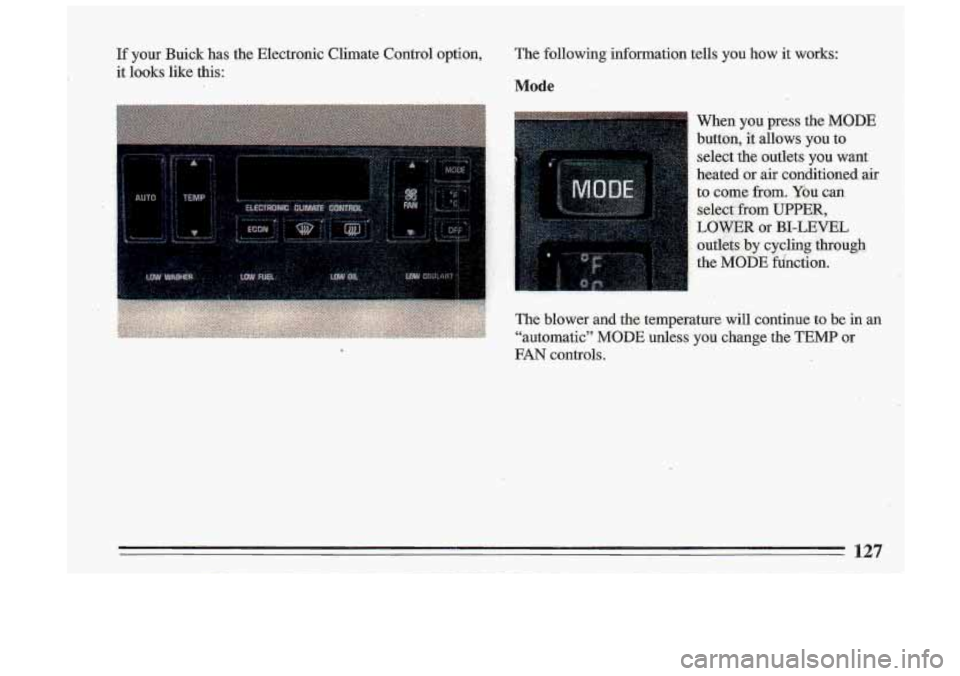
If your Buick has the Electronic Climate control option,
it looks like this: The
following information tells you how it works:
Mode
When you press the MODE
button, it allows you to
select
the outlets you want
heated
or air conditioned air
to come
fiom. Ybu can
select
from UPPE,R,
LOVWR or BI-LEVEL
outlets by cycling ihrough.
the
MODE fdnction.
The blower and the temperature will continue to be in an
“automatic”
MODE unless you change the TEMP or
‘I
FAN controls.
127
Page 135 of 340

i
the sun may adequately warm your upper body, but your
lower body may not be warm enough.
The Bi-level settbg directs outside air.into your vehicle
in two ways.-Cool air
is directed 'toward your upper
body through the front instrument panel outlets, ,while
slightly warmed
air is directed through the heater outlet
at
your feet.
.The air conditioner compressor operates in all Air
Conditioning positions, and the Defrost position when
.the outside temperature is above
40 OF (4.5 C).
R
Ventilation
For mild outside temperatures, when little heating ox ,
cooling is needed, slide the upper lever to Vent, Air will,'
flow through the .instrument panel outlets. Use the air
oudets to turn on, adjust and turn
off the air, flow. Adjust.
the lower lever to control the temperature;
'.
.. .
Heating
When outside temperatures are cold, 8liding:the upper .
lever to Heater and the' lower lever to :Warm will send,
heated air though the heater outlets, 'and-some through
the defroster vents. Vent and Heater arelabeled
economy positions. because the
dr conditioner
compres.sor doesn't run in these..two settings. "This . .
reduces engine load, resulting in impioyed I.. fyd.
economy.
Defrosting
The Defrost setting directs most of the- air through the
defroster vents, and some through.the heater outlets. Use
defrost when you want to remove fog
,6r ice from the
windshield.
133
Page 219 of 340
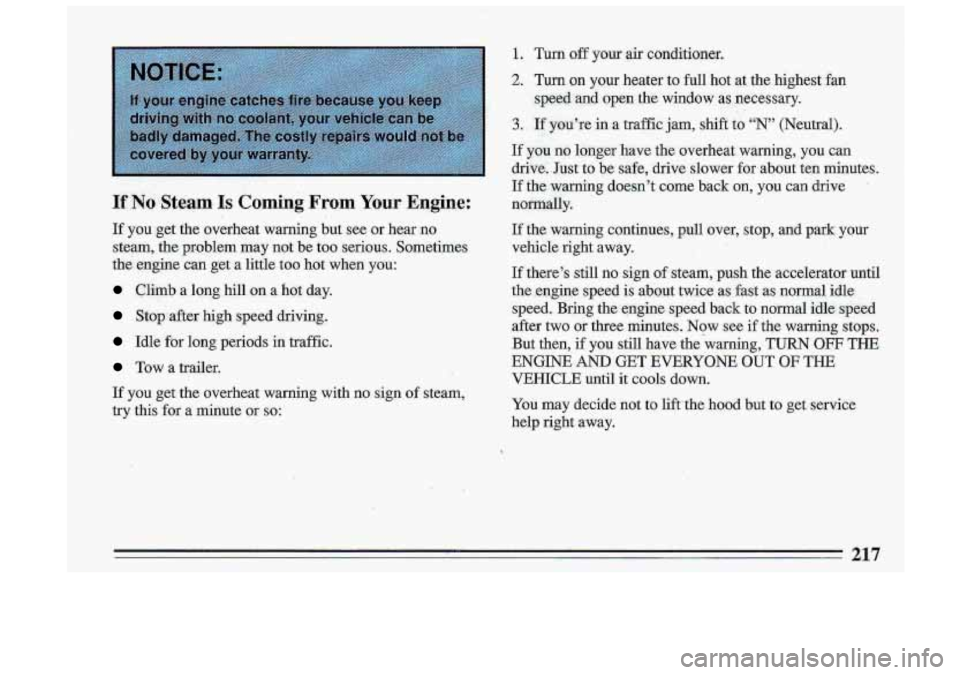
1. Turn off yom air conditioner.
If :No .Steam Is Coming From Your Engine:
If you get the overheat warning but see or hear no
steam, the problem may not be
too serious. Sometimes
the engine can get a little
too hot when you:
Climb a long hill on a.hot day.
Stop :after high speed driving.
Idle for long periods in traffic.
Tow a trailer.
If you get the overheat warning with no sign of steam,
try this
for a minute or so:
If there's still no. sign of steam, push the accelerator until
the .engine speed is about twice
as fast as normal idle-
speed. Bring the engine speed back
to normal idle speed
after two or three minutes.
Now see if the warning stops.
But then,
if you still have the-warning, TURN OF'F THE
ENGINE AND GET EVERYONE OUT OF THE
VEHICLE until it cools down.
You may decide not to 1ift.the hood but to get service
help right away.
217
Page 277 of 340
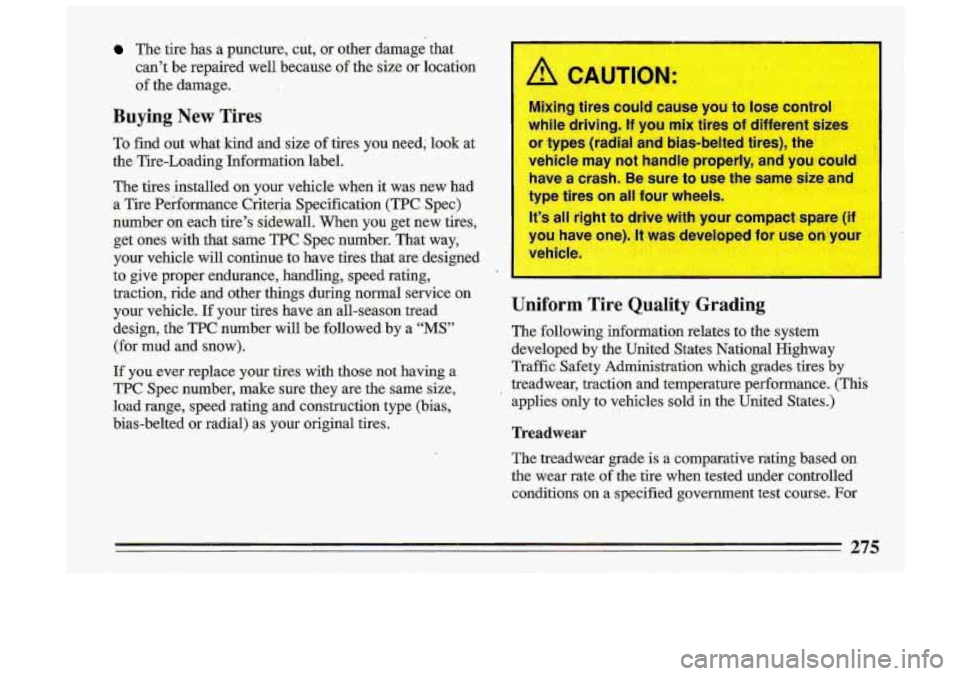
The tire has a puncture, cut, or other damage that
can’t be repaired well because of the size or location
of the damage.
Buying New Tires
.To find out what kind and size of tires you need; look at
the Tire-Loading Information label.
The tires installed on your vehicle when it was new had
a Tire Performance Criteria Specification
(TPC Spec)
-number on each tire’s sidewall. When you get new tires, get ones with that same TPC Spec number.
That way,
your vehicle will continue
to have tires that are designed
to give proper endurance, handling, speed rating,
traction, ride and other things during normal service on
your vehicle.
If your tires have an all-season tread
design, the
TPC nu-mber will be followed. by a “MS”
(for mad and snow).
If you ever replace your tires with those not having a
TPC Spec number, make sure .they are the same size,
load range, speed rating and construction type (bias,
bias-belted or radial) as your original tires.
‘t
A CAUTION:
Mixing tires could cause you to lose control
while driving. If you mix tires of different siz
or types (radial and bias-belted tires), the
vehicle may not handle properly, and you
cows
have a crash. Be sure to use the same size and
type tires
on all four wheels.
It’s all right to drive with your compact spare (if
you have one). It
was developed for use on your
I
I
‘ :le.
Uniform Tire Quality Grading
The following information relates to the system
developed by the United States National Highway
Traffic Safety Administration which grades tires
by
treadwear, traction and temperature performance. (This
applies only to vehicles sold
in the United States.)
Treadwear
The treadwear grade is a comparative rating based on
the wear rate of the tire when tested under controlled
conditions
on a specified govement test course. For
I
Page 279 of 340

Wheel Alignment and Tire Balance
The wheels on your vehicle were aligned and balanced
carefully at the factory to give you the longest tire life
and best overall performance.
In most cases, you will not'need to have your wheels
aligned again. However, if
you notice unusual tire wear
or your vehicle pulling one way
or the other, the
alignment may need to be reset.
If you notice your
vehicle vibrating when driving
on a smooth road, your
wheels may need to be rebalanced.
Wheel Replacement
Replace any wheel that is bent, cracked .I or badly rusted.
If wheel nuts keep coming loose, the wheel, wheel bolts,
and wheel nuts should be replaced.
If the wheel leaks air
out, replace it (except some aluminum wheels, which
can sometimes be repaired). See. your Buick dealer
if
any of these conditions exist.
Your dealer will how the kind
of wheel you need.
Each new wheel should have the same load carrying capacity, diameter, width, offset, and be mounted the
same way as the one it replaces.
If you need to replace-any of your wheels, wheel bolts,
or wheel nuts, replace them only with new
GM original equipment parts. This
way,
you will be sure to have the
right wheel, wheel bolts, and wheel
nuts for your Buick
model.
/! CA-TION:
Using the wrong replacement wheels, wheel
bolts, or wheel nuts on your vehicle can be
dangerous.
It could affect the braking and
handling of your vehicle, make your tires lose
air and make you lose control.
You could ,have a
collision in which you or others could
I !
bolts, and wheel nuts for reelacement. jured. Always use the correct wheel,
whec
I
.. ~ ~
277
Page 287 of 340
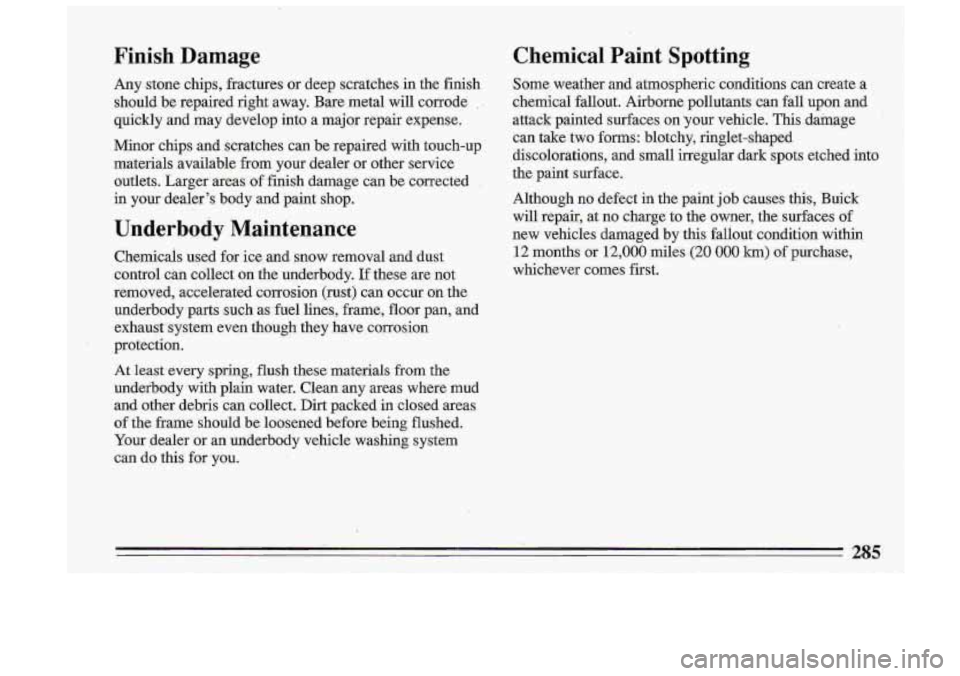
Finis,h Damage
Any stone chips, fractures or deep scratches in the fini.sh
should be repaired right away. Bare metal will corrode
quickly and may develop into a major repair expense.
Minor chips and scratches can be repaired with touch-up
materials available from your dealer .or other service outlets. Larger areas'of finish damage can be corrected
,
in your dealer's body and paint shop.
Un,derbody Maintenance
Chemicais used €or ice, and snow removal and-dust
control can collect
on the underbody. If these are not
removed, accelerated corrosion (rust) can occur .on. the
underbody.parts such as fuel lines, frame, floor pan, and
exhaust system even though they have corrosion
protection.
At least every spring, flush these materials from the
underbody with plain water. Clean any areas where mud
and other debris can collect. Dirt packed in closed areas
of the frame should be loosened before being flushed.
Your dealer or an underbody vehicle washing system
can do this for you.
Chemical Paint Spotting
Some weather and atmosphexic conditions can create a
chemical fallout. Airborne pollutants can fall upon and
attack painted surfaces
on your vehicle. This damage
can take
two forms: blotchy, ringlet-shaped
discolorations, and small irregular dark
spots etched into
the paint surface.
Although no defect in the paint job causes this, Buick
will repair, at no chaKge to the owner, the surfaces
of
new vehicles damaged by this fallout condition within
12 months or 12,000 miles.(20 000 km) of purchase,
whichever comes first.
9
t
285
Page 297 of 340
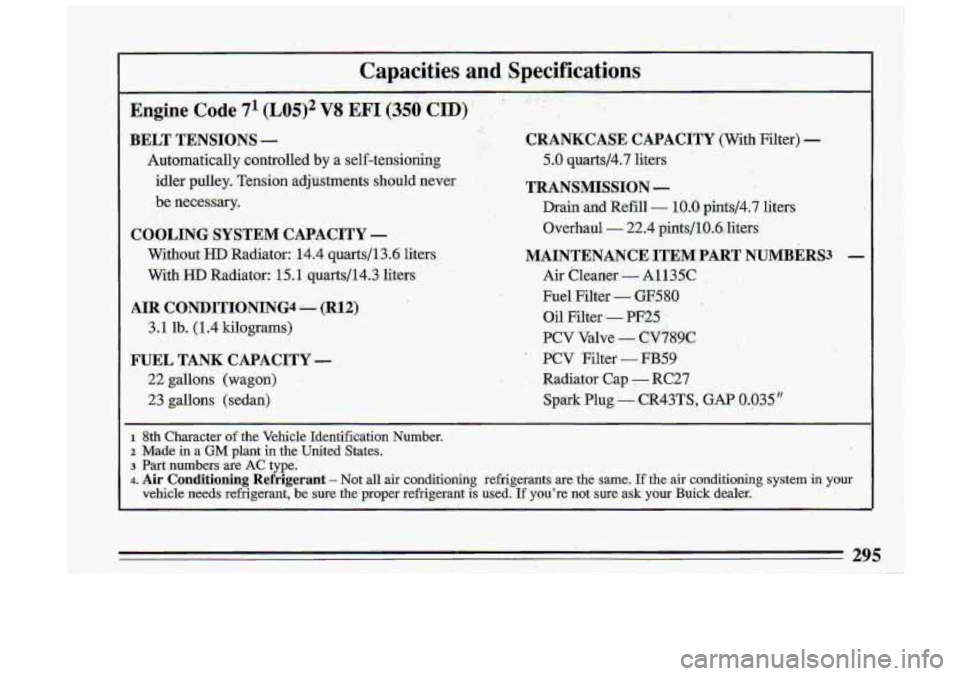
Cap.acities and, Specifications
CRANKCASE CAPACITY (With Filter) -
5.0 quarts/4.7 liters
TRANSMKSSIQN -
Drain and Refill - 1.0.0. pints/4.7 lifers
Overhaul
- 22.4 pints/f0.6.. liters
MAINTENANCE .ITEM PART NUMBERS3
Air Cleaner - A1.135C
Fuel Filtir
- GF580 ,
Oil Filter - PF2S
PCV Valve - C.V789C
’ PCV Filter - FB59
Radiator Cap - RC27
Spark Plug
- CR43TS, GAP 0.035”
1 8th Character of the Vehicle Identification Number.
2 Made in a GM plant in the United States,
3 Part: numbers are AC type.
4. Air Conditioning Refrigerant - Not all air conditioning refrigerants are the same. If the air conditioning system in your
vehicle needs refrigerant,
be- sure the proper refiigerant is used. If you’re not sure ask your Buick dealer;
295
Page 309 of 340

7.
8.
To help ensure-proper operation, we recommena a
pressure test of both’the cooling system and the
pressure cap. If you do not use your vehicle under any of these
conditions, change both the fluid and filter every
100,000 miles (1 60 000 km).
Front Wheel Bearing Repack - When your 9. Spark Plug Replacement* - Replace spark plugs
vehicle is used in such service as police work, as a with the proper type. See “Specifications Chart.’’ in
taxi or
in door-to-door delivery, clean and repackthe the Index.
front wheel bearings at each brake relining or
15,000 Spark plug Wire Inspection*? - Inspect for
miles (25 000 km), whichever comes first. If you
don’t use your vehicle in such service, clean
and
repack the bearings at each brake relining or 30,000 -
miles (50 000 km) whichever comes first. burns, cracks .or other damage. Check the boot fit
at
the distributor and at the spark plugs. Replace wires
as. needed.
Transmission Service - Change both the fluid and
filter every
15,000 miles (25 000 km) if the vehicle
is mainly driven under one or ‘more
of these
conditions:
In heayy city traffic where the outside
temperature regularly reaches
‘90 OF (32 C) or
higher.
In hilly or mountainous terrain.
When doing frequent trailer towing.
Uses such as found in taxi, police car or delivery
service.
11. Exhaust Gas Recirculation (EGR) System
Inspection*?
- Conduct the EGR system service
as described in the service manual.
To purchase a
service manual, see “Service Publications” in the
Index.
12. Air Cleaner Filter Replacement* - Replace every
30,000 miles (50 000 km) or more ofkn under dusty
conditions. Ask your dealer for the proper
replacement intervals for your driving conditions.
307
I